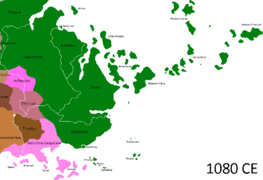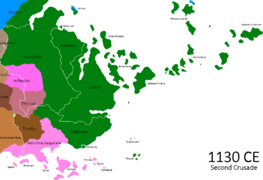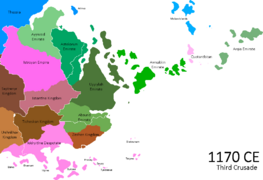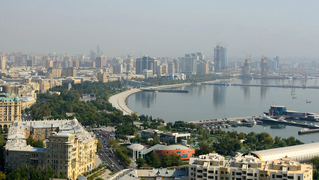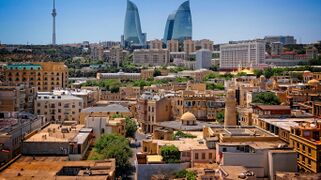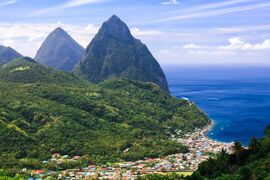Zeshinava
This article is non-canonical either because it refers to out-of-character content, the associated nations have left the region, or the information has been retconned. Accordingly, its content should not be considered to be part of the canonical structure of the region's lore.
|
The Neoteric Confederacy of Zeshinava Taz Nөvruvihn Sѧjioh-Tihnansyihӈ zat Zeжcihnωva (Zeshen) | |
|---|---|
|
Flag | |
Motto: Aжt dihmarz muvs yihnɛr өtuer ihnem! To love one's home above all! | |
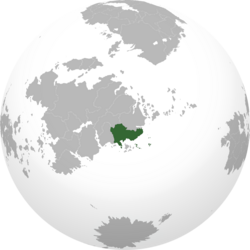 | |
| Location | Zeshinava in the Istroya region of southeastern Sarpedon |
| Capital and largest city | Kronzciny (Xronzsεnyy) |
| Official languages | Julian Ænglish, Zeshen |
| Recognised national languages | Istroyan, Zeshen |
| Minority languages | Latin |
| Demonym(s) | Zeshen (noun) Zeshen (adjective) |
| Government | Semi-Constitutional Parliamentary Unitary Republic overseen by an unelected Executive |
• Executive | Amelia Al-Ahzmira |
• Chancellor | Vaeran Khiaseak |
• Vice Chancellor | Violett Venihravihc |
| Legislature | Parliament |
| House of the Advisory & House of the Administration | |
| House of the Constituency | |
| Establishment | |
• Istroyan civilization established in Zeshinava | 800 BCE |
• Iddyritine Despotate conquered by Oduniyyad Caliphate | 900 CE |
• Zeshen Kingdom founded by crusaders | 1154 CE |
• Grand Duchy of Zeshinava founded | 1188 CE |
| Area | |
• Total | 1,184,531 km2 (457,350 sq mi) |
| Population | |
• Estimate | 85,476,530 |
• Census | 85,450,000 |
• Density | 72.2/km2 (187.0/sq mi) |
| GDP (nominal) | estimate |
• Total | $1,901,083,512,000 |
• Per capita | $22,241 |
| Currency | Zihase Ⱐ (ZSH) |
| Date format | dd/mm/yyyy CE |
| Mains electricity | 120 V 60 Hz |
| Driving side | right |
| Calling code | +138 |
| ISO 3166 code' | ZS |
| Internet TLD | .zs |
Zeshinava, officially the Neoteric Confederacy of Zeshinava, is a country in the Istroya region of southeastern Sarpedon. It is neighbored by Chrobonsk, the Sydona Islands and the Founders Sea. Zeshinava is a storied country inhabited by the indigenous Sarpedonic people, who migrated in droves to the southeast of the continent during the Crusades to aid the Iddyritine Despotate. The Zeshen and Iddyritine people assimilated with the establishment of the Zeshen Kingdom by the crusaders as the Oduniyyad Caliphate fell, though this saw resistance from the former exclusive High Sarpedonic ruling class. The falling Islamic powers took advantage of the squabbling peoples, leaving several independent emirates to take the lands of the Zeshens and Caliphate. The Fourth Crusade brought an end to the infighting, with the Zeshen Kingdom establishing itself in the northwest of present-day Zeshinava, the christening of the Absurian Empire along the south, and several other minor crusader states surviving in the east.
Zeshinava is a member of the League of Nations.
Name and Etymology

The name Zeshinava translates literally to "Lady Ava". The country bears her name as she founded the crusader state of the Zeshen Kingdom, Queen of the Zeshen Kingdom, and later the Grand Duchess of Zeshinava.
History
The Crusades
First & Second Crusade
With Pope Gregory VII preaching for the reconquest of Sarpedon's lost lands in 1084 as a Christian emergency thousands of Slavic men took the call to action and migrated from the Caphirian Slavic vassals of Central Sarpedon to the Oduniyyad-controlled southeast of Istroya. Though largely untrained, the collapsing Iddryitine Despotate made use of the influx of migrants to retake its lost lands. However, it would be some time before the masses could be made into an effective fighting force. The unskilled infantry allowed for the continued defense of the remaining Iddryitine lands, but the Odduniyad Caliphate maintained its hold on southeast Istroya through the first and second crusades. In 1120 during the Second Crusade Iddryitine forces were able to make minor gains in the Founders Sea. Forces launched from the Sydona Islands were able to capture Prevoy and Zavoy from local occupants. These islands and the surrounding archipelago weren't directly controlled by the Caliphate but were held by subservient Odduniyad merchants as trade outposts to reach other states on the south of the continent. The islands had to be sieged due to intense fortifications but were quickly forced to capitulate with Iddryitine naval superiority cutting off supply to the islands long enough. Tydoaea was seized in 1130 and led to a campaign to retake the islands of the Founders Sea for the Despotate.
Third Crusade
-
Istroya as of the First Crusade
-
Istroya as of the Second Crusade
-
Istroya as of the Third Crusade
-
Istroya as of the Fourth Crusade
As the Third Crusade approached though the Iddryitine Despotate gained a significant indigenous Sarpedonic population with little to no ties to the High Sarpedonic culture and state. The Iddryitine Despotate was not a Catholic state and was only serviced by the crusaders to combat the expansion of the Odduniyad Caliphate. When it came time to remove the caliphate from lands further into eastern Istroya though the Catholic crusaders would not allow their state to be led by non-Catholics. While the remaining outer lying islands of the Founders Sea were captured for the Iddryitine Despotate by 1150, the territory of the mainland would be established as state led by the crusaders directly. This state would come to be stablished with the onslaught of the Third Crusade and the Siege of Kronzciny. The crusaders formed a beachhead at the tip of Kronzciny island and cut off the island from the nearby mainland via the Obkhovid Canal. The knights were led by Adam Fonsphorum, the apparent son of Chaplain Otislav Fonsphorum. Otislav led a failed siege of the Melian Islands in 1139 after the northern islands were reconquered by the Odduniyad Caliphate but was honoured and well-regarded for his devotion to the Catholic faith. His son seemingly did not join their father and was unknown to even those that survived the failed siege of the Melian Islands. They were chastised for not joining their father at an earlier age and remained a low-ranking knight throughout their service starting in 1150. They served in the capture of Diakrunum in 1151, but otherwise only saw action on the Iddryitine front-line on the mainland. This was until the Siege of Kronzciny in 1154. Now 20 years old, Adam was charged with leading a cohort of knights past enemy lines to secure passage of crusader forces across the Obkhovid Canal. They were able to land on the shores while the bulk of Caliphate forces were preventing crusaders from crossing over from Kronzciny Island. Though Adam was tasked with taking out targets and clearing an alternative path for naval forces to make landfall they instead aided the populace in escaping from the city before the siege made it to the mainland. Once the invasion path was clear, they sent their men back without them, and went to meet the occupying authority of Kronzciny, Addas al-Ahzmira. Adam removed their armour, and revealed they were in fact not the son of Otislav Fonsphorum, but the daughter.
Lady Ava & the Siege of Kronzciny

Lady Ava, otherwise known as Avanira Fonsphorum (Avenɛra Fөnzvюrum in Zeshen), was a Slavic migrant from the Principality of Truřov that immigrated across the continent when Pope Gregory VII called for the reconquest of Istroya from the Oduniyyad Caliphate. Her father, Otislav Fonsphorum (Otaꙉѧlѧv Fөnzvюrum in Zeshen), took the call to arms when she was only 5. Ava begged her father not to leave, but out of religious obligation he travelled to Istroya among countless other thousands of Catholic men beckoned by the pope, leaving his home empty of a patron. To Ava's dismay, she had to remain in Truřov to help her family. Upon a fatal incursion by Oduniyyad raiders however, Ava was left among the few survivors in her village, with the fallen bitterly contesting their homes and livelihoods. In the grief she was left in by her family's passing, she set out to southeast Istroya to campaign alongside her people and seek retribution against her father for his abandoning of the family. Answering the call for aid from Despot Abcis III, Ava joined the ranks of the Iddryitine army under the name Adam. She fought with her legion to retake the outlying islands of present-day Zeshinava and distinguished herself as a skilled soldier considering her small stature. She would set herself apart however in the Siege of Kronzciny, seeking to liberate the people of the caliphate rather than expelling them. Moved by the families left behind by soldiers like her own, she led the people of Kronzciny to the safety of the Iddryitine-controlled shores and pled for the mercy of the Iddryitine authorities. In both fighting the cowardice of the caliphate and commanding compassion to the army leadership she earned herself the respect of her fellow soldiers. She would go on to meet with the occupying forces at the behest of her superiors, wearing a hijab in a show of tolerance and revealing her womanhood. She negotiated the defection of the occupying Muslim forces, and upon bearing the legitimacy of the Iddryitine armed forces and local Muslim ruling class, she proclaimed the Zeshen Kingdom, with occupying-leader Addas al-Ahzmira becoming King Addas, and Ava becoming Queen Ava. The two married, and their kingdom would bear the name of the woman that negotiated its foundation: Zeжcihnω Ava, or in English, Lady Ava.
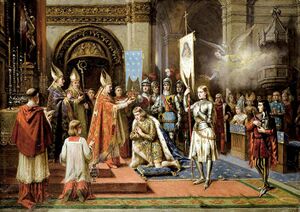
The Zeshen Kingdom continued to aid in the reconquest of Istroya from the remaining Odduniyad Caliphate and independent emirates. As the crusades came to a close however, the Catholic Church cracked down on Zeshen Kingdom and declared Lady Ava a heretic for wearing men's clothes and marrying a Muslim man. She risked being tried for blasphemy and excommunicated from the Catholic world unless she repented for what she had done. She repented for her wearing of men's clothing and agreed to resign from bearing arms. The Church forbid her from divorcing despite her husband being a Muslim man, and the Zeshen Kingdom was restructured into a grand duchy with the Christian Despot of the Iddryitine Despotate, Theodoric Abcis, becoming Archduke. Theodoric was crowned Archduke of Zeshinava in 1188 CE and converted to Catholicism. Lady Ava became Grand Duchess Ava, and her husband Addas Al-Ahzmira becoming the Grand Duke. Though on roughly equal footing, it was expected that Ava would lead the state with Theodoric rather than Addas, with the Grand Duke title only serving as a technicality on Addas' name. The Iddryitine Despotate remained in the form of the Free Cities of Sydona which would stay under the exclusive control of Archduke Theodoric. This situation allowed Lady Ava to avoid persecution, excommunication, and potentially revolution at the hands of a population angered by her heretical actions, she still remained out of the good graces of much of the Catholic world and was largely forced to resign to the more traditional role of the female leaders of the Middle Ages.
Following the collapse of the Caliphate in Sarpedon the new Grand Duchy of Zeshinava would assume the role of the trade hub of the south of the continent. While other major powers were mired by internal conflict through this period, the southern islands would maintain their place as trade hubs despite a new authority. While the Free Cities of Sydona shied away from interaction with the Muslim world, Zeshinava would lean into its position as a bridge between cultures and continents. This served to placate the subservient Muslim population of the officially Christian country and allowed conflict like the inquisitions through the rest of Sarpedon to be avoided, though not without disapproval from the Catholic Church. Formerly at odds with the Caliphate, Audonian rulers would remain amicable with the Grand Duchy as to maintain a semblance of influence on the continent. This further angered the religious population, and the Church used this to their advantage to gain influence against the Caliphate. The Church, for its part in the Crusade, claimed the lands the crusaders regained from the Absurid Emirate for Christendom. This once again divided Zeshinava's government but ensured a pause to the accusations of heresy against the royal family of the Grand Duchy. The Archduke appointed lands to a newly designated class of Christian nobility, comprised of the most decorated soldiers in the war and those with the best means to provide for their subjects. Local Muslim leaders with wealth made through trade with the former Caliphate were deposed to make way for the new ruling class. These nobles swore fealty to Zeshinava and to protect the land, but their loyalty was primarily to the Church and the local Christian population it served. This left the fledgling state vulnerable as the Crusades continued to their final wave, the Fourth Crusade.
Fourth Crusade and Piracy
With the forces of the Zeshen army firmly established in Istroya by the turn of the century, the Church called upon the crusaders for their fourth and final crusade. This fight would take them away from the mainland to establish control over the Sea of Istroya. Much of the crusade took place at sea as the crusaders attempted to establish positions in allied Qustantistan to push into the outer Istroyan islands. While allowing the crusade to take place to establish further control over outer Istroya, the royalty worried about so much of their army being away from the homeland and leaving it vulnerable to invasion. These worst fears would be realised too, with the trade of the southern Zeshen islands losing its security guaranteed by the Duchy. Muslim pirates would begin using the islands as bases to raid ships coming down the Istroyan island arch, and this led to a significant economic decline in Zeshinava. While the caliphal holdouts east of Qustantistan were disposed of, Zeshinava became increasingly isolated with such dangerous waters many dared not to travel. The Archduke attempted travel to Urceopolis to meet with the pope, but his ship too was raided by pirates. Grand Duke Addas, enraged that a head of state had been captured and left without appropriate protection on his travels, decreed that the bishops of Zeshinava would be appointed directly by the state and call an end to the crusades. By 1220 CE the Zeshen army had all returned to the country, but some brought home a rebellion against what they saw as an undermining of the Church by removing their Bishops. This would culminate in the beginning of the War of the Churches.
War of the Churches
The War of the Churches began immediately upon the return of crusaders to eastern Zeshinava. While others went directly to Kronzciny to meet with the royals, rebel ships docked primarily at the mouth of the Pīyocia River and took lands from occupying nobles for themselves. Other rebellious nobles went to their lands and started local uprising against the crown.
Geography
-
Picturesque view of the Kronzciny waterfront.
-
The Tricameral Towers pictured in the background of the Kronzciny Historical District.
-
The twin peaks of Little Dia and Big Dia on the subtropical island of Diakrunum.
Physical Geography
Zeshinava is defined by its bountiful rivers and the flood plains made in their wake. One such river is the River Vakar, which defines Zeshinava's western border with Chrobonsk. Meanwhile, the majority of Zeshinava's population, including that of its capital, sits at the mouth of the Istroya delta. The Dlyīmihnav branches into various different directions and wraps around the Kianal mountains of the northwest to meet the population centers of the basin frontier. The Dlyīmihnav flows into the Bay of Sydona along the Īsiagal mountain range from the northern border to the south, splitting the country in two. This split creates a contrast between the floodplains of the west and the largely flat and dry expanse of the east. Meltwater from the Īsiagal Mountains drain into the Pīyocia River, which feeds north into Flounders Bay. This leaves the southeast unabated by divisive geographic features. Lastly, the outlying islands of Zeshinava are mostly mountainous, with the only exceptions being the smaller few formed more recently by volcanism.
Zeshinava is home to numerous volcanoes through its two major mountain ranges and outlying islands. Magma hotspots coupled with seismic activity mark the lands existence at the confluence of tectonic plates. The geological activity however allows for extensive geothermal energy production and would make Zeshinava and energy exporter if not for the activity extending into surrounding nations. Still, this, among other resource advantages, gives Zeshinava a strategic geographic position despite its lesser connection to larger economies. The aforementioned Dlyīmihnav River plays into this strategic position, as it is the only outflow of the large Istroyan Delta. The river regularly floods and brings sediment downstream, keeping the soil fresh and rich. Zeshinava thus possesses large farmland, created out of the expansive grasslands of the south before they transition into forests when travelling away from the major bodies of water.
Zeshinava is largely made up of extended continental crust, as evidenced by its southern lowlands. In contrast, the north of the country is part of the Absurian Orogeny, thus resulting in its notable volcanic activity. The geologic activity has deposited various minerals throughout the orogeny, such as manganese, aluminum, gold, chromium, among other minerals found in igneous rock.
Climate and environment
Is your country hot or cold?
Government and Politics
How is your country ruled or governed?
Executive
Who is responsible for making high level choices in your country? Does it have a President or King?
Legislative
Who decides the laws for your country? Is there political parties and a legislature?
Federal subdivisions
How is your country divided? Are there states or provinces, or is the country directly governed from the capital as a unitary state?
Politics
What political factions exist? Who has ruled predominantly?
Law
What kind of laws and legal system does your country employ?
Demographics
What kind of people live in your country?
Ethnicity
What ethnic groups make up your country?
Language
What language or languages do your country's people use? Are there any previously used languages no longer common? Are these languages native to your country or shared with another?
Religion
Religious affiliations in the XXX (20XX)
What do your country's people believe in religiously, if anything? How many groups are there?
Education
How many people in your country are educated?
Culture and Society
What do your people do, and what are they like?
Education
What is your country's education system like? How do the schools work? What do people think about education?
Attitudes and worldview
How do your country's people view life?
Kinship and family
How are families or kinship groups structured in your country?
Cuisine
What do your people eat?
Religion
What do your people believe? Rather than demographics, as above, think about how important religion is to your people and their view about their own and other religions. What is the relationship between the prevailing view and minority religious groups? Is it an official religion, and do any laws exist about free worship?
Arts and Literature
What type of art do your people make? Do they have a tradition of painted art, well-crafted television shows, or great music?
Sports
Does your country have any major sports leagues? What types of sports are played, both professionally and for fun by your country's people?"
Symbols
Are there any prominent symbols which are well known to represent your country?
Economy and Infrastructure
How does your country's economy work?
Industries and Sectors
What are the largest parts of your economy in terms of what they do?
Currency
What exchange systems are used within your country's economy?
Healthcare
How do people in your country procure medical care? How is it paid for?
Labor
How is labor organized within your country? Are there any social institutions or unions which deal with labor concerns?
Transportation
How do people in your country get around? Is there a major highway system as well as sea- and airports?
Energy
What type of energy keeps your nation going? Are you renewable or use fossil fuels, and if you are renewable, how recently did your country transition?
Technology
How advanced is your country? Is it an innovator, or does it largely import new developments?
Military
How large is your country's military? Is it large but poorly equipped or small and elite? Does your country have a martial tradition?

